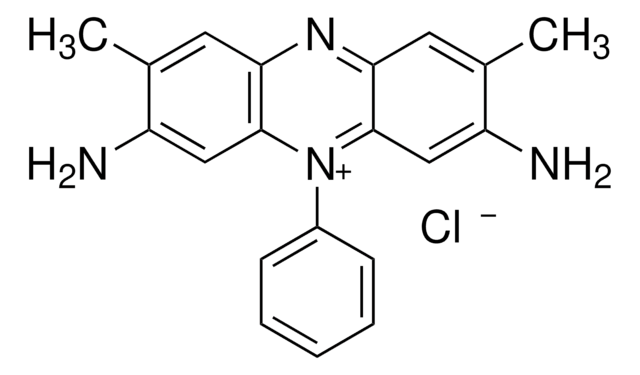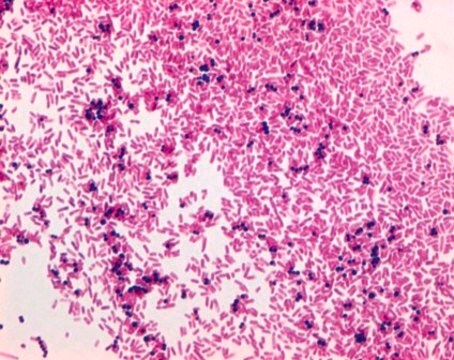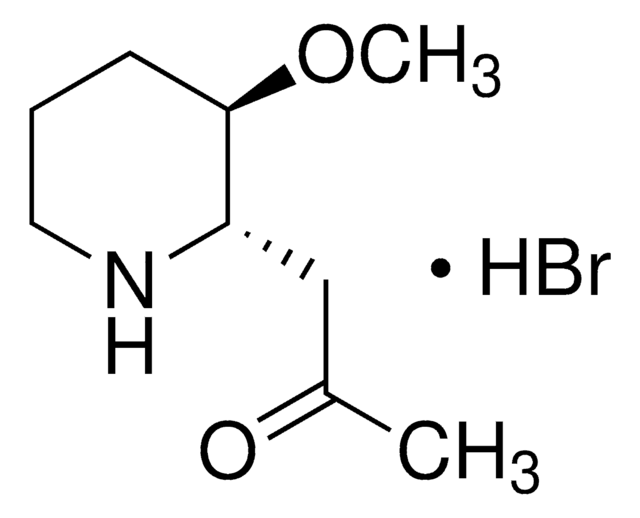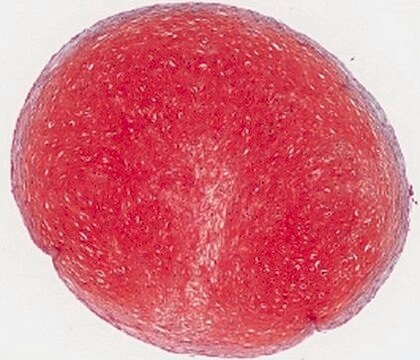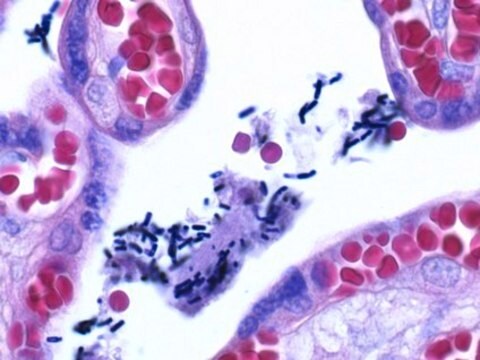94635
Gram-Safranin -Lösung
for microscopy
Synonym(e):
Safranin T -Lösung
About This Item
Empfohlene Produkte
Qualität
for microscopy
Qualitätsniveau
Form
liquid
Haltbarkeit
limited shelf life, expiry date on the label
Zusammensetzung
ethanol, 10%
Methode(n)
microbe id | staining: suitable
Farbe
red to very dark red
Brechungsindex
n20/D 1.339
Löslichkeit
water: soluble at 20 °C
Dichte
0.986 g/mL at 20 °C
εmax
4.0 at 532 nm in 50% ethanol
Wirkungsspektrum von Antibiotika
Gram-negative bacteria
Gram-positive bacteria
Anwendung(en)
diagnostic assay manufacturing
hematology
histology
Lagertemp.
room temp
SMILES String
[Cl-].Cc1cc2nc3cc(C)c(N)cc3[n+](-c4ccccc4)c2cc1N
InChI
1S/C20H18N4.ClH/c1-12-8-17-19(10-15(12)21)24(14-6-4-3-5-7-14)20-11-16(22)13(2)9-18(20)23-17;/h3-11H,1-2H3,(H3,21,22);1H
InChIKey
OARRHUQTFTUEOS-UHFFFAOYSA-N
Suchen Sie nach ähnlichen Produkten? Aufrufen Leitfaden zum Produktvergleich
Allgemeine Beschreibung
Anwendung
- as a non-toxic replacement for crystal violet for the quantification of biofilm formation
- to develop a hyaluronic acid visualization method
- to study improved β-lactam susceptibility against biofilm-embedded staphylococcus aureus by 2-aminothiazole
Leistungsmerkmale und Vorteile
- Ready-to-use solution.
- Modified and designed in such a way that staining can be carried out in staining cells, on the staining rack, and in automated staining systems.
Prinzip
Signalwort
Warning
H-Sätze
Gefahreneinstufungen
Flam. Liq. 3
Lagerklassenschlüssel
3 - Flammable liquids
WGK
WGK 2
Flammpunkt (°F)
114.8 °F
Flammpunkt (°C)
46 °C
Persönliche Schutzausrüstung
Eyeshields, Faceshields, Gloves, type ABEK (EN14387) respirator filter
Hier finden Sie alle aktuellen Versionen:
Besitzen Sie dieses Produkt bereits?
In der Dokumentenbibliothek finden Sie die Dokumentation zu den Produkten, die Sie kürzlich erworben haben.
Kunden haben sich ebenfalls angesehen
Artikel
Clostridia are relatively large, gram-positive, rod-shaped bacteria that can undergo only anaerobic metabolism.
On the Trail of Campylobacter - The Campylobacter is one of the leading causes of human gastroenteritis. Common Campylobacter species C. jejuni, C. coli, and C. lari are responsible for most cases of campylobacteriosis. However, other species, like C. fetus, which causes spontaneous abortions, have also been associated with human illness. Campylobacter are Gram-negative, spiral-shaped, microaerophilic and motile bacteria with uni- or bi-polar fl agella
An article regarding the Role of Clostridium perfringens and their detection, identification, and differentiation from Sigma-Aldrich.com
For microbiologists the most fundamental stain was developed in 1884 by the Danish bacteriologist Hans Christian Gram.
Unser Team von Wissenschaftlern verfügt über Erfahrung in allen Forschungsbereichen einschließlich Life Science, Materialwissenschaften, chemischer Synthese, Chromatographie, Analytik und vielen mehr..
Setzen Sie sich mit dem technischen Dienst in Verbindung.
